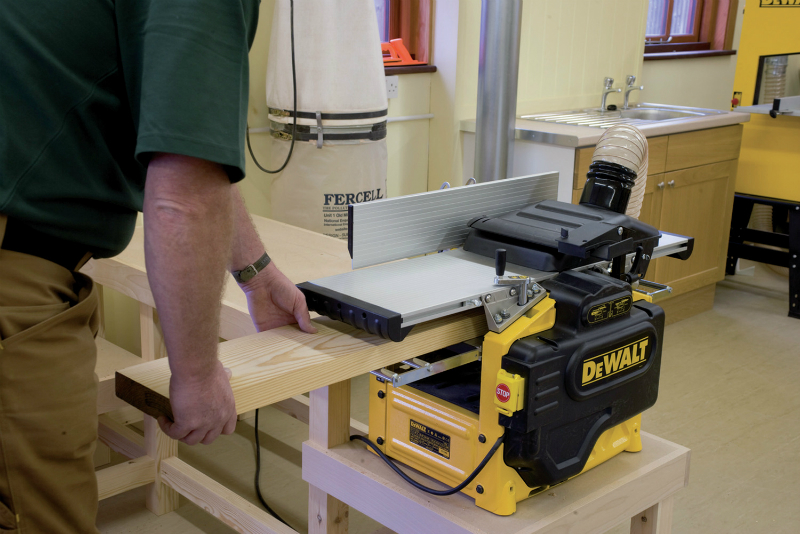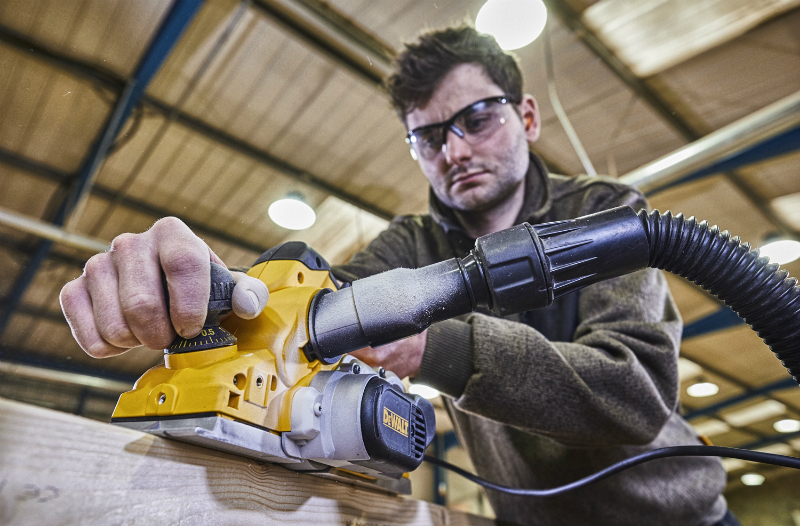
Planer and Thicknesser buying guide
Planers & Thicknessers: The 30-Second Buying Guide
| Brand | Model | Type | Price |
|---|---|---|---|
| DEWALT | DW733 | Thicknesser | £510 |
| DEWALT | DCP580N | Planer | £131 |
| MAKITA | DKP180Z | Planer | £138 |
| MAKITA | 2012NB | Planer / Thicknesser | £617 |
| BOSCH | GHO-26-82-D | Planer | £167 |
| MAKITA | DKP181Z | Planer | £227 |
| MAKITA | KP0800 | Planer | £121 |
Planer and Thicknesser uses:
- Smoothing – planers and thicknessers can be used to smooth rough or uneven surfaces on wood.
- Levelling – planers are frequently used to level the sides/ends of doors and worktops. Thicknessers are often used to level floor joists and supporting beams.
- Chamfering – this is the process of removing sharp edges of a material, which is usually performed by a planer rather than a thicknesser.
Things to consider when buying a Planer or thicknesser:
- Planing width: Planers are typically used to trim sides/ends of materials, whereas thicknessers are often used to give a straight clean finish to the surface of sawn timber. Our portable thicknessers can typically trim boards up to around 300mm in width. Planers typically come with a blade width of 56mm or 82mm.
- Planing depth: Our handheld planers and portable thicknessers vary in how much material they can trim, up to a maximum of around 4mm.
- Wattage – higher wattage planers and thicknessers generate more power.
- Power source – 110v for work sites, 240v for home use, or cordless planers for manoeuvrability.
Planers: The guide to make your choice plane and simple
Difference between a planer and thicknesser
Planers and thicknessers are both used to trim thin pieces of material from a board (usually wood).
Planers are hand-held, mobile power tools where the machine is typically taken to the material for cutting. They are normally used to trim the sides or end of a wooden board by a few millimetres, such as a door.
On the other hand when using a thicknesser, the material is taken to the machine for cutting. Thicknessers are usually capable of wider cuts than planers and are usually used to trim the surface of a wooden board to a consistent thickness. Our portable thicknessers are designed to plane the thickness of boards with a maximum width of around 300mm.
Key uses for planers and thicknessers- Smoothing: Planers and thicknessers can be used to remove a thin layer from a wooden board or to trim off any impurities. This may be to enhance the finish of the board.
- Levelling: Although a planer or thicknesser will follow the wood to an extent, they can straighten out kinks. Planers are ideal for levelling the ends/sides of a wooden board. They are not typically used to level large surfaces on wooden boards, as you will often be restricted by the width of the planer cutting blade. Planers are often used by carpenters to trim doors so that they fit perfectly into a door frame. Thicknessers are most often used to level the surface of a wooden board, such as a floor joist or supporting beam. The wooden board is fed through the thicknesser and a layer is cut off the material. In order to produce a completely level surface using a thicknesser, the alternate surface of the wooden board (the surface sliding on the base of the portable thicknesser) will need to be flat.
- Chamfering: This involves making a 45 degree cut on the edge of a wooden board to remove an existing 90 degree angle. This may be done for safety reasons or just to make the edge more aesthetically pleasing.
Key Considerations When Buying A Planer or Thicknesser
 Some of the key considerations when looking to purchase a planer or thicknesser are:
Some of the key considerations when looking to purchase a planer or thicknesser are:
Planing width: The majority of planers have a standard width of 82mm but there are a few that have smaller widths such as 56mm. Our portable thicknessers can come in different widths, but these are usually around 200- 300mm. As you would expect, the wider the cutting blade on a planer or thicknesser the more material can be removed in a single pass so the job can be completed in less time. The main drawback with a portable thicknesser is that the size of the blade is also the maximum width of board the machine can accept. The height of a portable thicknesser may also restrict the height of the board that can be fed through the machine. This makes portable thicknessers ideal for long, relatively narrow, pieces of wood such as beams or floorboards. Anything wider or higher will not fit through the machine. A planer has a width of 82mm but it can plane larger items (such as the side of a door) as the tool is taken to the material and you are not restricted by its width.
Planing depth: The other thing to consider is the planing depth. Hand held planers and thicknessers will have a planing depth of around 0-4mm per pass. If you need to remove more then this will need more passes, but generally a planer is used when the amount of wood that needs to be cut off is too thin for a Saw to perform. Different models of planers and thicknessers vary in the depth of cut they can perform, so check the specification of the power tool depth to ensure it meets your requirements prior to purchasing.
Wattage: Higher wattage will give slightly more power. If you are planing dense wood or need to remove a large amount of wood then a higher wattage is best so that you don't put so much strain on the motor.
Power source: Planers are available in mains 240v and 110v (for site work) and also in 18v or 12v cordless options. The mains and 18v planers are comparable in performance so it mainly comes down to preference. Cordless will allow you more movement and flexibility in areas to work but the mains option will give you constant power without the need to change or charge batteries. Thicknessers are not currently available in a cordless option due to the size and power they need to operate.
Extras: Most planers will have a dust extraction option via a dustbag or dust extractor
Planer and Thicknesser Safety
 Ensure the device is switched off before you plug it in: You should also make sure that you have adjusted the machine to the correct thickness before you turn the power on to avoid damage to fingers or hands that could be near the blade.
Ensure the device is switched off before you plug it in: You should also make sure that you have adjusted the machine to the correct thickness before you turn the power on to avoid damage to fingers or hands that could be near the blade.
Read the manual and understand how it works: Thicknessers and planers are very different machines. If you use one type or model it doesn't mean you know how to use the other. Reading the manual will make sure you get the best use of your tool.
Wear the right clothing and protective gear: Goggles or glasses with side protection are essential as a planer can regularly have small pieces of wood fly out from the work area.
Keep loose clothing away from the machine: Particularly with thicknessers, it is essential to make sure that loose clothing is kept away from the motor. If it gets caught this could result in serious injuries.
View our range of Planers and Thicknessers and find the lowest prices online at Howe Tools.


